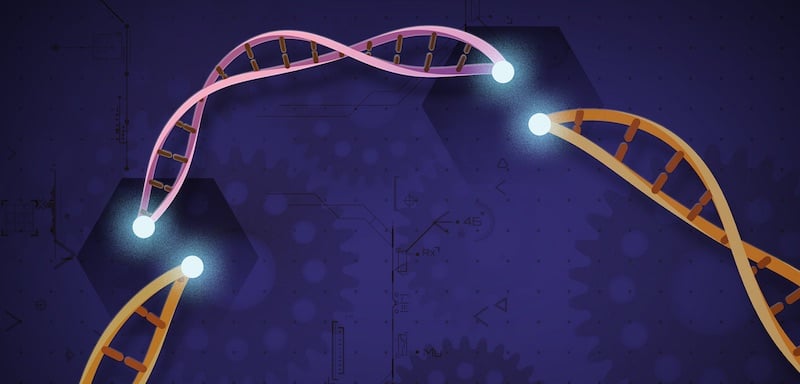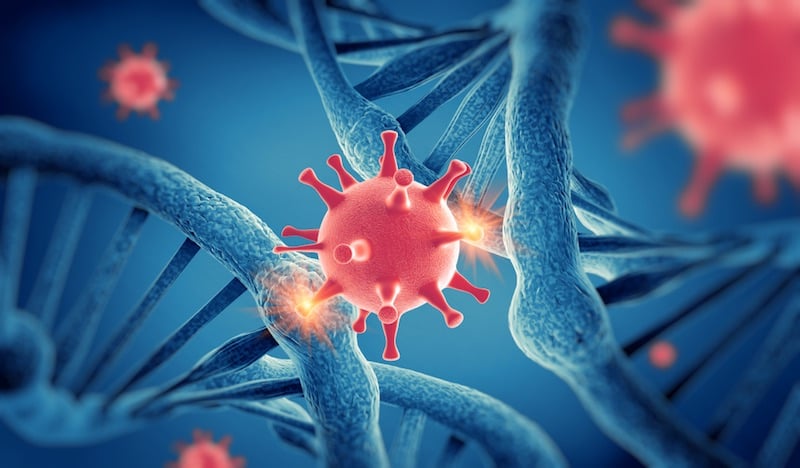What Is Crispr Being Used For
CRISPR technology offers the hope to cure any human being genetic illness with gene editing; which one will exist the showtime?
CRISPR-Cas9 was starting time used as a factor-editing tool in 2012. In merely a few years, the technology has exploded in popularity thanks to its promise of making gene editing much faster, cheaper, and easier than ever earlier.
CRISPR is brusk for 'clustered regularly interspaced short palindromic repeats.' The term makes reference to a serial of repetitive patterns found in the Dna of bacteria that form the footing of a primitive immune arrangement, defending them from viral invaders by cutting their DNA.
Using this natural procedure every bit a basis, scientists developed a gene-editing engineering science called CRISPR-Cas9 that tin can cut a specific Dna sequence past simply providing it with an RNA template of the target sequence. This allows to then add, delete or replace elements within the target DNA sequence.
This system represented a big leap from previous factor-editing technologies, which required designing and making a custom Deoxyribonucleic acid-cutting enzyme for each target sequence rather than just providing an RNA guide, which is much simpler to synthesize.
CRISPR gene editing has already changed the way scientists do research, allowing a wide range of applications across multiple fields. But the technology could besides concur bully potential as a treatment for human diseases. In theory, CRISPR could let usa edit any genetic mutation at will to cure any disease with a genetic origin. In exercise, however, CRISPR is nonetheless in the beginning stages of its therapeutic development.
Content continues beneath
Related Content
Hither is a list of some of the first diseases that scientists are tackling using CRISPR-Cas applied science, testing its possibilities and limits as a medical tool.
1. Cancer
Communist china has been spearheading the starting time clinical trials using CRISPR-Cas9 as a cancer handling. One of these studies was testing the utilise of CRISPR to modify immune T cells extracted from the patient. The gene-editing technology is used to remove the factor that encodes for a protein called PD-one. This poly peptide institute on the surface of immune cells is the target of some cancer drugs such every bit checkpoint inhibitors . This is because some tumor cells are able to bind to the PD-1 protein to block the immune response against cancer.
The trial tested this approach in 12 patients with non-small prison cell lung cancer at the West Prc Hospital. The results, published in Apr 2020, suggested the arroyo was viable and rubber.
Still, a later on article pointed out that the report revealed some of the technology'southward limitations, including variable efficiency in the genome-editing process. Some experts have recommended that the long-term safety of the arroyo remain under review. Others accept suggested using more than precise gene-editing approaches such as base editing .

In the U.s.a., a phase I trial run by the University of Pennsylvania tested the rubber of a similar approach. The researchers used CRISPR to remove three genes that help cancer cells evade the immune arrangement. They and then added another factor to help the immune cells recognize tumors. T he results revealed that the handling was prophylactic in patients with advanced forms of cancer.
Content continues below
Related Content
Meanwhile, the company CRISPR Therapeutics is currently running a global stage I trial that is expected to recruit over 130 patients with blood cancer to test a Motorcar-T prison cell therapy fabricated using CRISPR engineering science.
two. Blood disorders
The blood disorders beta-thalassemia and sickle prison cell disease, which affect oxygen send in the blood, are the target of a CRISPR treatment existence developed by CRISPR Therapeutics and its partner Vertex Pharmaceuticals.
The therapy consists of harvesting os marrow stem cells from the patients and using CRISPR technology in vitro to make them produce fetal hemoglobin. This is a natural form of the oxygen-carrying protein that binds oxygen much meliorate than the conventional adult form. The modified cells are so reinfused into the patient.
In December, preliminary results revealed that all five patients with thalassemia haven't required any blood transfusions since receiving the treatment , and the two patients with sickle cell illness accept so far not experienced whatsoever of the usual bleeding episodes acquired by their status.
Hemophilia is another blood disorder that CRISPR technology could tackle, although development is still at the preclinical stage. CRISPR Therapeutics is working with Casebia on an in vivo CRISPR therapy where the gene-editing tool is delivered directly to the liver. Last year, Intellia Therapeutics and Regeneron Pharmaceuticals teamed upward to pursue the development of hemophilia treatments based on genome editing.
three. Blindness
Many hereditary forms of incomprehension are caused by a specific genetic mutation, making it easy to employ CRISPR-Cas9 to care for it by targeting and modifying a single gene. In addition, the activeness of the allowed system is limited in the centre, which tin can circumvent any problems related to the body rejecting the treatment.
The company Editas Medicine is working on a CRISPR therapy for Leber congenital amaurosis, the well-nigh common crusade of inherited childhood blindness, for which in that location is currently no handling. The treatment aims to use CRISPR to restore the function of light-sensitive cells before the children lose sight completely by fixing the most common genetic mutation behind the disease.
Concluding year the company started a stage I/II trial, with results expected by 2024. This is the first trial to examination an in vivo CRISPR treatment, in which the gene editing happens directly within the patient's body rather than on cells extracted from their torso and and so returned to information technology.
iv. AIDS
There are several ways CRISPR could assistance usa in the fight against AIDS. One is using CRISPR to cut the viral Dna that the HIV virus inserts within the Dna of allowed cells. This arroyo could be used to assail the virus in its hidden, inactive class, which is what makes it impossible for most therapies to completely get rid of the virus.

Another approach could make us resistant to HIV infections. Certain individuals are born with a natural resistance to HIV thanks to a mutation in a gene known equally CCR5, which encodes for a protein on the surface of immune cells that HIV uses as an entry bespeak to infect the cells . The mutation changes the structure of the protein so that the virus is no longer able to bind to information technology.
This approach was used in a very controversial case in Mainland china two years agone in which human embryos were genetically edited to make them resistant to HIV infections. The experiment caused outrage amidst the scientific customs, with some studies pointing out that the 'CRISPR babies' might be at a higher risk of dying younger. The general consensus seems to be that more research is needed before this approach can be used in humans, particularly as recent studies have pointed out this practice tin take a high risk of unintended genetic edits in embryos.
5. Cystic fibrosis
Cystic fibrosis is a genetic disease that causes astringent respiratory problems. Although there are treatments bachelor to deal with the symptoms, the life expectancy for a person with this disease is only around 40 years. CRISPR technology could help the states get to the origin of the problem past editing the mutations that cause cystic fibrosis, which are located in a gene called CFTR .
Concluding year, researchers in the Netherlands used base editing to repair CFTR mutations in vitro in the cells of people with cystic fibrosis without creating damage elsewhere in their genetic code. In addition, companies such every bit Editas Medicine, CRISPR Therapeutics, and Beam Therapeutics have plans to develop treatments for cystic fibrosis using CRISPR systems.
Cystic fibrosis can exist caused by multiple different mutations in the target gene, however, pregnant that dissimilar therapies volition take to be developed for different genetic defects. Editas Medicine has stated that it will be looking at the almost common mutations, as well as some of the rare ones for which in that location is no treatment.
6. Muscular dystrophy
Duchenne's muscular dystrophy is acquired by mutations in the DMD gene, which encodes for a protein necessary for the contraction of muscles. Children born with this disease suffer progressive muscle degeneration, and existing treatments are limited to a fraction of patients with the condition.
Research in mice has shown CRISPR engineering science could be used to fix the multiple genetic mutations backside the disease. In 2018, a grouping of researchers in the The states used CRISPR to cutting at 12 strategic 'mutation hotspots' covering the bulk of the estimated 3,000 unlike mutations that cause this muscular disease. A visitor chosen Exonics Therapeutics was spun out to farther develop this arroyo.

Editas Medicine is also working on a CRISPR therapy for Duchenne'due south muscular dystrophy. The visitor is post-obit a broader arroyo where instead of fixing specific mutations, CRISPR gene editing is used to remove whole sections of the mutated protein, which makes the protein shorter but still functional.
7. Huntington's illness
Huntington's disease is a neurodegenerative condition with a strong genetic component. The disease is caused by an abnormal repetition of a certain DNA sequence within the huntingtin gene. The college the number of copies, the earlier the disease volition manifest itself.
Treating Huntington'south could be tricky, equally whatsoever off-target furnishings of CRISPR in the encephalon could take very dangerous consequences. To reduce the take chances, scientists are looking at ways to tweak the genome-editing tool to get in safer.
In 2018, researchers at the Children's Hospital of Philadelphia revealed a version of CRISPR-Cas9 that includes a self-destruct push button . A grouping of Polish researchers opted instead for pairing CRISPR-Cas9 with an enzyme called nickase to brand the gene editing more precise .
8. Covid-19
In the face of the Covid-19 pandemic, CRISPR has quickly been put to the apply of making fast screening tests. In the longer term, the gene-editing tool might permit u.s. to fight Covid-19 and other viral infections.
Scientists at Stanford University have developed a method to plan a version of the gene-editing engineering known as CRISPR/Cas13a to cut and destroy the genetic material of the virus backside Covid-19 to stop it from infecting lung cells . This approach has shown to reduce the viral load in human cells by 90% and to work against 90% of all existing and emerging coronaviruses.
Another research group at the Georgia Institute of Technology has used a similar arroyo to destroy the virus before it enters the cell. The method was tested in live animals , improving the symptoms of hamsters infected with Covid-19. The treatment also worked on mice infected with flu, and the researchers believe it could be constructive confronting 99% of all existing flu strains.
The hereafter of CRISPR engineering
Because that CRISPR-Cas9 is a relatively new evolution in the world of biology, research has only begun to scratch the surface of the role it could play in the future of medicine. The examples listed here are but the showtime attempts at using CRISPR engineering as a therapy. As they progress, nosotros can expect more than and more indications to be added to the listing.
One of the biggest challenges to turn this research into real cures is the many unknowns regarding the potential risks of CRISPR therapy. Some scientists are concerned most possible off-target effects likewise equally immune reactions to the gene-editing tool. Just equally research progresses, scientists are proposing and testing a wide range of approaches to tweak and amend CRISPR in order to increase its efficacy and prophylactic.
Hopes are high that CRISPR-Cas9 technology will shortly provide a way to target and destroy complex diseases such as cancer and AIDS, and even target genes associated with mental illnesses.
Images via NIH /Flickr; Shutterstock. This article was originally published in June 2018 and has since been updated to reflect the latest developments in CRISPR research.
What Is Crispr Being Used For,
Source: https://www.labiotech.eu/best-biotech/crispr-technology-cure-disease/
Posted by: fitzgeraldlecous.blogspot.com


0 Response to "What Is Crispr Being Used For"
Post a Comment